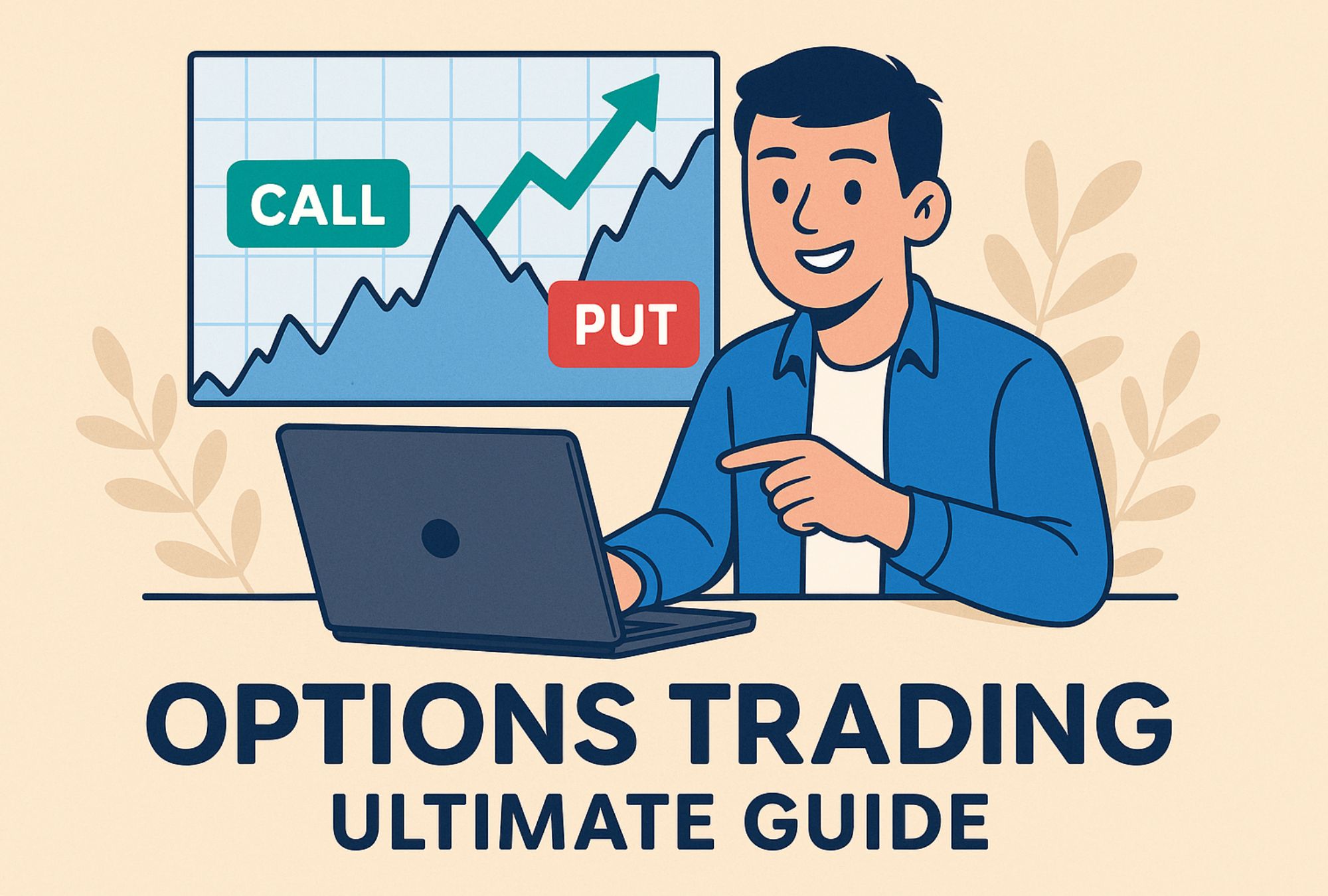What is Options Trading? The Ultimate Beginner’s Guide

Read time: 20 minutes
Ever find yourself scratching your head trying to learn about options trading? You’re not alone. Options can sound confusing at first (like complex Wall Street jargon), but it doesn’t have to be intimidating.
So what is options trading?
In simple terms, options trading is the practice of buying or selling special contracts (called options) that give you the right – but not the obligation – to buy or sell an asset (like a stock) at a set price by a certain date.
It’s a flexible way to invest in the market beyond just buying stocks. But if you’re a beginner, don’t worry. This guide breaks down everything you need to know – in plain English!
By the end, you’ll know what options are, how they work (with simple examples), and how options trading compares to stock trading. Sound good? Perfect. Let’s dive in!
What Is Options Trading?
Options trading means buying or selling an option contract. And an option is a financial contract between two parties.
This contract gives one party (the buyer) the right – but not the obligation – to buy or sell an underlying asset (usually a stock) at a specific price within a specific time period.
The other party is the seller (or “writer”) of the option, who collects a fee (called a premium) for giving the buyer this right and is obligated to fulfill the contract if the buyer decides to exercise the option.
You can think of it like putting down a deposit to hold an item at a store: you pay a small fee to lock in the price, and then you have the right to buy that item by a certain date. If you decide not to buy, you lose the deposit, but you’re not forced to buy the item.
In a similar way, an option buyer can choose to exercise their right to buy or sell the stock at the agreed upon price (called the strike price) by the expiration date – or choose not to if it’s not beneficial.
The option seller keeps the premium regardless of whether the option is exercised or not.
Options Trading: Key Terms
- Call vs. Put. There are two main types of options contracts: call options and put options. A call gives you the right to buy the asset, while a put gives you the right to sell the asset. (We’ll explain each in detail in the next section.)
- Expiration Date. Every option has an expiration date. You can only use the option (exercise it) up until that date. After expiration, the contract expires worthless if not used.
- Strike Price. This is the set price at which you can buy or sell the underlying asset if you exercise the option.
- Premium. This is the price you pay to buy the option (or the money you receive if you sell an option). It’s essentially the cost of having the “right without obligation.”
Options are a type of derivative, which means their value is derived from an underlying asset (like a stock). If the underlying stock’s price goes up or down, the value of the option will generally change accordingly.
People use options in three main ways: to speculate on price movements, to hedge or protect against risk, or to generate income by selling options.
When you trade options, remember you’re not trading the actual stock – you’re trading the right to buy or sell that stock.
This makes options trading different from regular stock trading.
How to Start Trading Options (Step-by-Step)

Getting started with options trading is a process. Here’s a simple roadmap:
Step 1: Learn the Basics
Continue educating yourself (like you are right now). Make sure you understand the key concepts: calls vs. puts, strike price, expiration dates, how option pricing works at a basic level, etc.
Read beginner guides, watch videos, or try an options trading simulator with play money to see how trades work. You can even play with one of our free options calculators to get a better understanding of how everything works.
Many brokerages offer free educational resources and paper trading accounts – use them. As you probably already know, the more knowledge you have, the more confident you’ll feel when you do make that first trade.
Step 2: Open a Brokerage Account with Options Trading
Choose a brokerage platform that allows options trading and open an account. Note that you’ll likely need to request options trading privileges when setting up the account (or later in your account settings).
Your broker will likely ask about your investing experience before granting options trading permission. Once approved, you can fund your account with the amount you plan to trade.
Step 3: Start Small with a Simple Trade
When you’re ready to place your first options trade, start small.
Consider trading just a single contract on a stock or ETF you’re familiar with. Decide if you are bullish or bearish and choose the appropriate basic strategy (buy a call if bullish, or buy a put if bearish).
Choose a strike price and expiration date that match your expectations and research – not too aggressive (deep out-of-the-money or expiring in two days) but also not too conservative. A little risk is normal with investing.
Double-check all the details (correct stock symbol, call vs. put, strike price, expiration date) before confirming the order. It’s also wise to use a limit order (naming your price) when buying or selling an option, so you don’t end up overpaying due to a quick market move.
Step 4: Monitor and Manage
After entering the trade, keep an eye on it. You don’t need to stare at the screen all day, but track how the stock’s movement affects your option’s price. And have an exit plan.
For example, you might decide, “If this option doubles in value, I’ll take profits…” or “If it loses half its value, I’ll cut my losses.”
Many options traders choose to sell the option contract before expiration to realize a profit or limit a loss, rather than exercising the option. Just be mindful of the expiration date – if an option is in the money and you hold it to expiration, your broker might automatically exercise it or assign it (resulting in buying or selling the underlying stock).
If you don’t actually want that to happen, make sure to close the position beforehand. After the trade is over, take note of what happened and learn from the experience.
Each trade (win or lose) can teach you something for the next one. Remember to only risk an amount you’re comfortable losing (especially as you learn).
Your Options Trading Journey Is Just Starting
If you’ve made it this far, then congratulations! You’ve just completed a complete crash course on options trading – seriously, well done!
By now, you should understand what an option is, the difference between calls and puts, and the basic strategies and mechanics of how options trades work. So the next step for you is to apply this knowledge. You can start with a paper trading account or a very small real trade to test the waters.
Use free tools like OptionsProfitCalculator to understand your profit potential and how things work better.
But keep in mind the golden rules: don’t risk money you can’t afford to lose, stay informed, and always have a plan (i.e., know why you’re entering a trade and when you’ll exit).
Experience is an awesome teacher – even a “bad” trade can show you how options work in real life. So good luck on your options trading journey, and happy trading!
Options FAQs
Can I trade options with $100?
Yes, it’s possible to start trading options with around $100, but your choices will be limited. With $100, you will likely be able to buy only one low-cost option contract at a time (for example, an option priced at $0.50 per share would cost $50 per contract). You should be aware that a small account like this means you’re putting all your eggs in one basket on a single trade. If that one trade doesn’t work out, you could lose the entire $100. Having a bit more capital (say a few hundred dollars) gives you more flexibility to diversify or choose options that are a bit more likely to pay off (e.g. options that are closer to the current stock price, which cost more but have a higher chance of ending in the money). The key is to manage expectations. Starting with a small amount can be a great learning experience, but don’t expect to turn $100 into $10,000 overnight. Think of it as paying for education – you’re learning how options behave. As you gain experience (and possibly add funds), you can gradually increase your trade size.
Is options trading gambling?
No, but the answer really depends on your approach. If someone randomly buys a bunch of weekly out-of-the-money call options on a hot stock, hoping to double their money in two days, that’s essentially gambling – it’s high risk with little analysis, similar to betting at a casino.
But options trading in itself is not gambling; it’s a financial strategy. Think of it this way: if you buy a stock without any research, that’s gambling. If you buy a stock with research and a strategy, that’s investing. The same goes for options.
Educated traders use options to manage risk (like buying a put to insure a portfolio) or to make calculated bets on market movements with defined risk. They often have probabilities in mind and use strategies to tilt odds in their favor.
On the other hand, inexperienced traders might dive in without understanding what they’re doing, which can quickly lead to losses – and that can feel like gambling. The key is knowledge and strategy. With the right approach, options trading becomes a calculated form of trading, not pure chance.
Who controls the options market?
No single person or entity controls the options market. The prices of options are determined by the forces of supply and demand in an open marketplace, just like stocks. In the U.S., options trade on several regulated exchanges (such as the Chicago Board Options Exchange (CBOE), NASDAQ, NYSE American, and others). These exchanges provide the platform for trading and set standardized terms for the contracts (like available strike prices and expiration dates).
The Options Clearing Corporation (OCC) acts as a central clearinghouse to ensure all option contracts are honored, and regulators like the SEC oversee the market for fairness and stability.
Market makers (specialist trading firms) also play a big role – they continuously buy and sell options to provide liquidity, which helps keep the market running smoothly. But ultimately, the market is like an auction — prices are set by what buyers are willing to pay and sellers are willing to accept for each option. If more people are buying a particular option, the price will rise; if more are selling, the price will fall.
So, while the structure of the options market is maintained by exchanges, clearinghouses, and regulators, the prices in the options market are controlled by the collective actions of traders and investors worldwide.